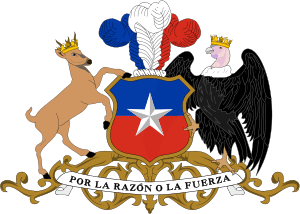Chilean mythology
Chilean mythology is the mythology and beliefs of the folklore of Chile.
Description
Chilean mythology is a multitude of myths and legends from the beliefs of Chile's indigenous groups (Mapuche, Tehuelche,...); and others of European origin, mainly of the Spanish colonization of Chile.
This variety of sources of beliefs caused, in some cases, a fusion of different beings of various mythological origins, and this has complemented and differentiated the Chilean mythology (ex. Chilota mythology).
Likewise, the differences in landscape and climate throughout Chile have formed defined geographical zones that underwent different historical circumstances which have intervened and favored the apparition of new, distinct beliefs and myths that have served to enrich the country's mythology.
Mythological division
In the study and classification of ″Chilean mythology″, the most used classification is the division by geographical zones; dividing by mythologies corresponding to the northern, central, and southern zones of Chilean territory; zones which can be further subdivided.
Myths and legends in the Northern Zone
The myths and legends of the Northern zone of the country are characterized as generally presenting characters and legends closely related to the desert, religious devotion, and mining. Examples of these myths include: the myth of Alicanto, la Lola, el Yastay, the Achaches, the Umpillay, and the Quilpaná, in addition to legends like Juan Soldado, the treasure of Guayacán, the Payachatas, La Tirana, and the virgen of Andacollo. The northern myths feature a profound influence from the Inca and many of the pre-Incan civilizations of the area, but they have adapted a characteristic of their own through a rooted base in Spanish colonialism; these manifest themselves through parties and celebrations en each region.
Myths and legends in the Central Zone
The central zone of Chile being the most populated and the site of the first Spanish colonial establishments, the emergence of a unique mythology emerged in the Chilean colonial era. This mythology was characterized by an assimilation of many mythological beings arising from Mapuche tribal beliefs.
The myths and legends of this zone contain many versions modified from oral tradition. Some of the most popular and well known mythological figures include: Pedro Urdemales, la Calchona, la Llorona, el Culebrón, el Chonchón, and the Piuchén; legends include: the Inca Lagoon, the Burial of Cacique Vitacura and Rere's Bell. Additionally, there are many references to stories about the appearance of the devil (El Mandinga, and of encounters with witches.
Further emphasized is the insular mythology of the central zone with the Easter Island mythology, and others like the legend of the treasure of Juan Fernández, in the Juan Fernández archipelago.
Easter Island myths and legends
Of all of the mythologies in the insular central zone, the strongest and most important source is Easter Island. Much like what has occurred in other parts of Chile, Easter Island mythology also developed from a very particular world view. This led habitants of Easter Island to create very singular explanations about the creation of man and their land. Examples of these myths include: Make-Make and Aku-Aku.
Myths and legends in the Southern Zone
This zone presents it's mythology and legends, in part, from many of the same colonial stories present in the central continental zone of Chile; as well as myths and legends influenced by/or belonging to Mapuche indigenous beliefs. Some of these beings and legends of this zone in Chile include the City of the Caesars, The Three Pascuales, and spirits of Mapuche beliefs like Pillán, the Wangulén, the Wekufes, the Anchimallén, Tenten and Caicai, and the Cuero, among many others.
Myths and legends in Chiloé
In the Southern zone, the myths and legends of the Chiloé Archipelago possess a distinct character from those of the rest of the country, due to the geographical isolation and the union of indigenous and Spanish traditions. Phenomenons like mist, strong winds, thick forests, and rough seas have been part of the inspirational source of a nourished mythical tradition, that represents itself through characters and scenes. The most important myths and legends of Chiloé are: the Caleuche and the Trauco, followed by the Fiura, the Pincoya, the Invunche, the Camahueto, the Basilisco chilote, and the Millalobo.
Mythologies and legends
The most important Mythologies and Legends are:
- Indigenous:
- Mapuche mythology
- Rapa Nui mythology
- Others:
- Chilota mythology
- City of the Caesars
- Alicanto
Iconography
Marcela Donoso, Chilean painter, made a set of oil paintings describing 30 relevant Chilean myths. A collection book has been made of these paintings.
See also
References
- Antonio Acevedo Hernández. Leyendas de Chile. Colección Leyenda y tradición. Biblioteca Quimantú para todos. Quimantú, 1971. (Spanish)
- Keller Rueff Keller R. Mitos y leyendas de Chile. Enciclopedia moderna de Chile. Editorial Jerónimo de Vivar, 1972. (Spanish)
- Yolando Pino Saavedra. Folktales of Chile. Routledge & K. Paul, 1967.
| |||||||||||||||||||||||||||||||||||||||||||||||||||
